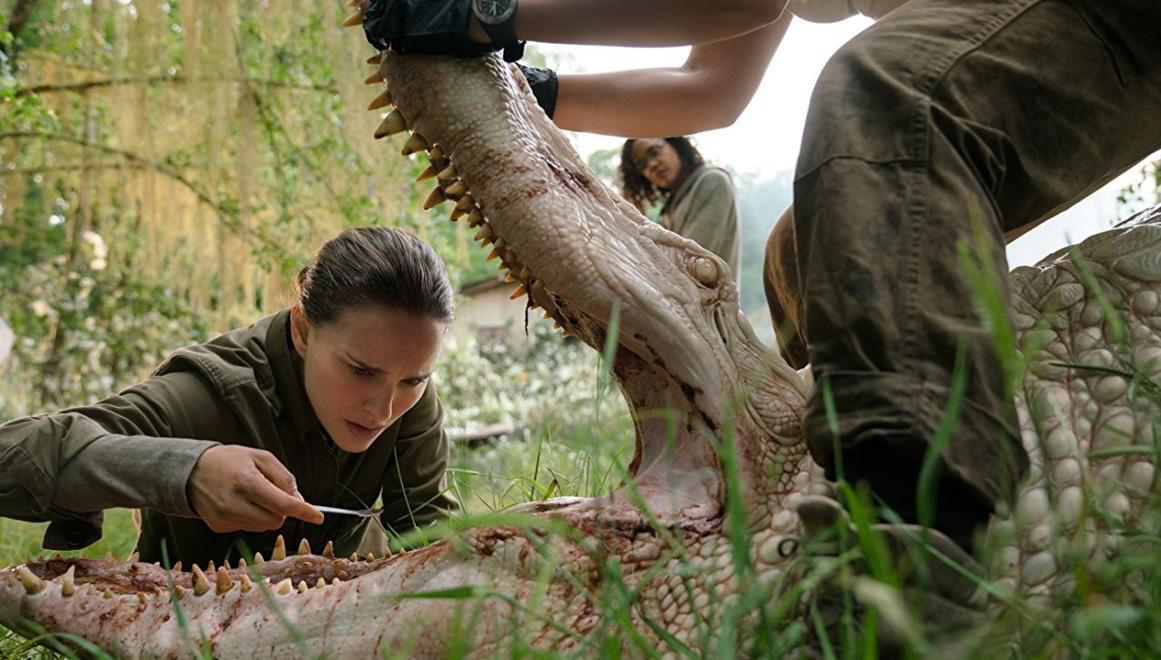From its opening credits, “Annihilation” instantly feels like the start of a nightmare. It feels off — a deliberate combination of robotic acting and a greyed color pallette. Its characters range from cold to creepy, it denies the audience necessary information and it runs almost like a parody of a million other military-esque sci-fi movies from “Avatar” to “Arrival.”
But director Alex Garland is too smart to fall into his own trap. His story is an instant failure, but it’s a small sacrifice, meant to preserve the film’s larger body of incessant emotional disturbance. This isn’t a movie about a character, a quest or some sort of lofty message. It’s a movie about communicating a deeply distressing feeling of utter corruption, of touring the audience through an intricately designed world where it’s impossible to feel at ease.
Lena (Natalie Portman) is one of a group of five scientists sent to investigate the Shimmer, a massive ever-expanding sinister soap-bubble from which nobody returns intact (if they return at all). Their mission is to investigate the Shimmer’s source, an extraterrestrial object that we see obliterate a lonely lighthouse in the film’s opening minutes.
The story quickly tapers off, as Garland abandons most vestiges of plot or characterization: Lena is as one-note as her companions (though she receives significantly more screentime), and their scientific squadron serves only as the vehicle to move us through the Shimmer’s dreamlike irreality. They’re museum tour guides, meant to show off the incredible artistic skill on display in the film’s visuals.
Most of the Shimmer’s world is only partially recognizable — an alligator makes a rapid appearance … but it’s pale and white, and it’s teeth are aligned in shark-like rows. Tropical trees loom over swamps like on any Costa Rican postcard … but their trunks are covered with an inexplicable technicolor fungus. The film’s production design successfully extends the feeling of the uncanny valley to an entire world (with the help of a soundtrack of eerily throbbing synths), modifying reality just enough to prevent the audience members from ever settling in their seats.
Garland compliments this feeling with a style of brutal body horror that would make even Jigsaw cringe. No punches are held as impromptu surgeries and disgusting dismemberments are shown as clearly as the monstrous creatures that sometimes cause them. The decision only makes sense; if the film’s goal is to make you uncomfortably squirming in your chair, it might as well go all-out.
But despite its horror elements, “Annihilation” is about as far from horror as “Blade Runner.” Though it uses some of that genre’s conventions effectively, its ultimate goal isn’t to frighten. “Annihilation” is home to images of stunning beauty, crystalline trees looming over otherwise destitute beaches, plants spontaneously flowering into human forms. This is a movie that deserves to be seen on the biggest possible screen, from the opening scenes of relative boredom to its show-stopping Giger-esque finale.
In places, however, “Annihilation” feels diluted. A flashback structure both breaks the film’s focus with entirely unnecessary (and completely ineffective) attempts at sympathizing Lena, and destroys much of the tension its barebones plot otherwise would have held (we’re shown from an early scene that Lena will survive). Wes Anderson-esque title cards also feel extraneous, and the few scenes of stilted dialogue are little but unnecessary distractions from the main event.
All this may have been the result of the behind-the-scenes producer drama (Garland’s vision was a bit too intellectual for Paramount), but in the end, the film’s core is so unerringly powerful that such peripheral problems are easily forgiven. That core is a sensation of deep, unsettling, nightmarish emotional disturbance, making “Annihilation” one of the most intentionally uncomfortable filmgoing experiences since “Se7en.” This is a beautiful, brutal, and brilliant film, one that understands that the purpose of film need not be to tell a story, but only to communicate a feeling (even if that feeling is ultimately distressing). Though it will debut on Netflix only seventeen days after theatrical release, it should undoubtedly be caught in theaters. It’s never pleasant, and often harder to swallow than a bottle of Everclear, but if you can stomach its bizarre brand of nightmarish world, “Annihilation” will leave you disquieted, haunted and utterly wonderstruck.
Contact Noah Howard at noah364 ‘at’ stanford.edu.
